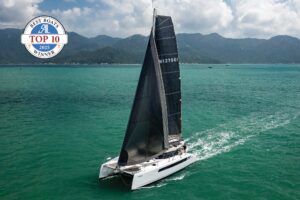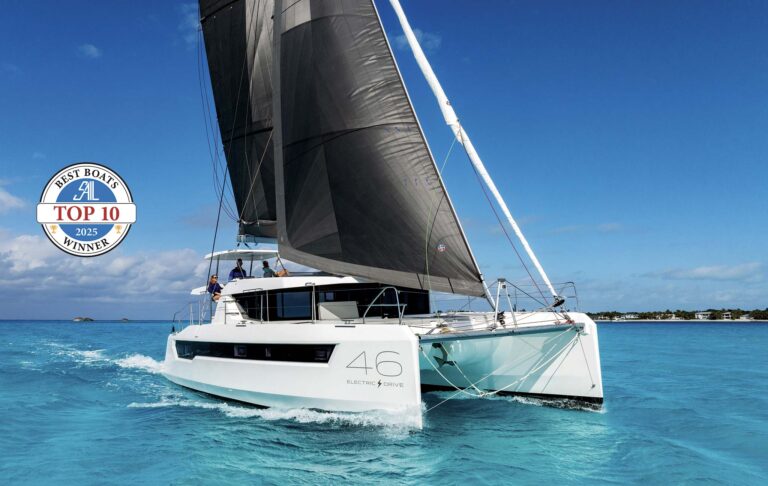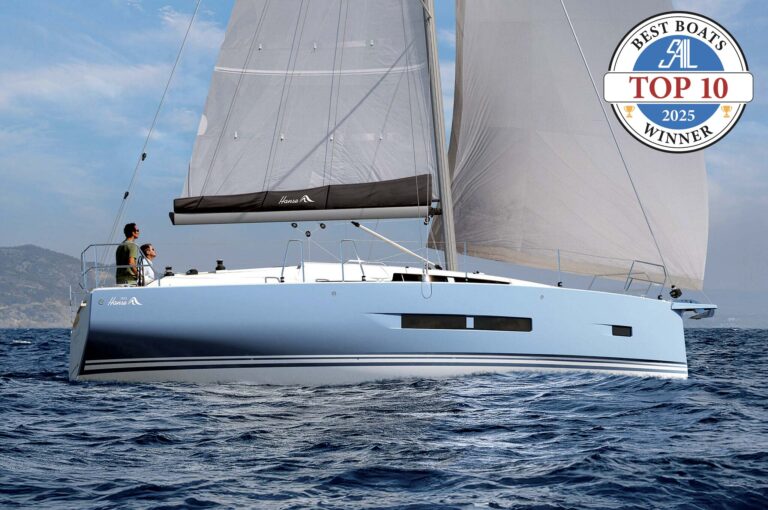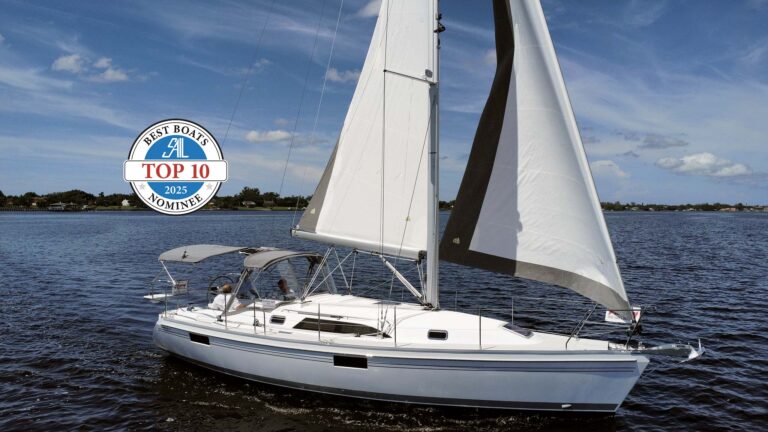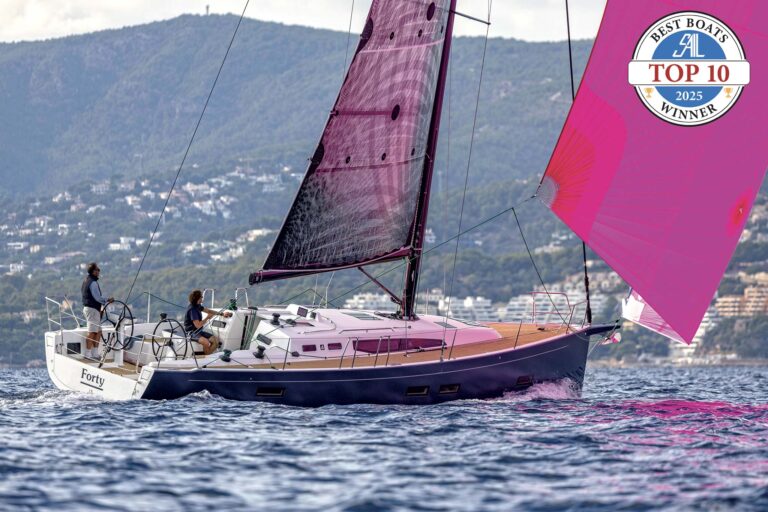The wave roared up behind us, trying to push the big boat around, but she wasn’t having it. Instead, we surfed, speeding ahead and touching 14.4 knots, inspiring an enthusiastic “whoop whoop” from the crew. We had just hoisted the gennaker on the new Nautitech 48 Open in 20 knots of breeze outside of Government Cut off Miami Beach. Alex Sastre of Performance Yacht Sales, who had sold one of these just that morning and who doesn’t shy away from calamitous conditions, is always fun on a sea trial. “I think we really have something in this boat,” he shouted over the wind. “They got it right!”
I inspected the boat from the dock before departure, and at first glance she looked like the Nautitech 44 Open (a SAIL Top 10 Best Boats 2023 winner) but with more elbow room and better windlass access. But once we untied the docklines, she proved to be so much more than just a longer waterline and extra breathing space.
The N48 was the last design of the late naval architect Marc Lombard, and it’s the flagship of the French builder’s line. She’s relatively light for her size with just over 13 tons of displacement, and her long, slim keels—no daggerboards—keep her tracking well. The knuckles of the reverse bows are above the waterline and the hulls are narrow down low with a chine to add volume up higher. Overall, she has a low profile with sleeker lines than previous Nautitech models and more like those of the high-performance uber cats. She looks like she means business even tied to the dock.
Nautitech likes to paint their aluminum masts black for a faux carbon effect. On the N48, this double-spreader rig supports nearly 1,400 square feet of sail area between the huge square-top mainsail and the self-tacking jib. Attach a code zero to the composite sprit and you have serious canvas acreage flying.
The helms are outboard on the hulls with B&G MFDs on both sides and the engine throttles to starboard, although you can add them to port as well. New are the helm seats, which were widened to accommodate two real-sized humans. Electric winches near both helms make easy work of the halyards, sheets, and reefing lines. The traveler and mainsheet run across and on top of the transom where they’re in sight of the skipper and quickly accessible rather than hidden up on the bimini.

There are no tricky newfangled concepts here, just intuitively organized sailing so this boat is easy to manage even shorthanded. That’s one of the design’s goals, says Miguel Guimaraes, Nautitech’s commercial export director. “We want everything to be easy. You can go around the world, but you don’t need complex systems.” Using daggerboards as an example, he noted that with its slender keels, the 48 can make 38 to 40 degrees apparent wind angle (AWA) upwind in chop (a statement that we verified in our test sail). “We are delivering a great package that sails well already.”
Visibility from the helms is decent forward and improves with the help of a mast-mounted camera. Aft, you can see both corners clearly, which is key when docking in reverse. That’s much better than driving from a flybridge model where you see nothing aft. On passage, it’s likely the boat will be on autopilot, so these exposed helms won’t be much of an issue. But day sailing and hand steering from here is the real attraction with excellent helm feel and a wind-in-your-hair experience. This is different from bulkhead-mounted helms on other brands, and it can be a polarizing feature. Nautitech has stuck to their guns with this approach over the years, and I think they’re right. This placement of the wheels provides the skipper with full view of the sails and also instills a sense of adventure since you’re closer to the water as it rushes by.
In gusty winds of 18 to 22 knots, we sailed 12.3 knots of boatspeed at 60 degrees AWA. She kicked up her heels, never feeling overpowered or squirrely. Off the wind, she tracked well despite the lumpy seas, and we still held onto 8 knots at 120 degrees AWA.

The foredeck has space for lounge cushions behind the twin trampolines and the windlass is now in an opening locker, which is an improvement over the N44. The bows are cavernous spaces that swallow lines and fenders. Two forward steps lead up to the coachroof where the boom is low enough for crew to manage the sail in the bag. Also up here are 1,800 watts of solar panels on the centerline.
Nautitech’s Open concept was popularized a few years ago on the N40. The idea was to maximize the size of the cockpit for outdoor living, leaving a small interior salon. This saves space, weight, and duplication. Of course, when you have 48 feet to work with, you can do a fine job of both.

The cockpit is truly roomy with twin hi/lo tables, a wide synthetic teak sole, and lots of garage stowage. Inside, the layout follows the N44 but is bigger in every sense. The table with the L-shaped dinette to port is now more than a cocktail lounge, and the forward-facing nav desk in the front port corner is the roomy nerve center of the boat. The galley with twin fridge drawers and ample countertops is to starboard, and in the middle is the trademark stand-up bar, which creates a central gathering spot to mix cocktails, prep food, gather and chat, or just hang on in a seaway.

The owner’s suite spreads across the entire port hull with a large double bed aft, a desk and generous closet space in the middle, and a head with a shower stall and twin sinks in the bow. Indirect lighting and improved finishes create a posh owner’s hideaway.
On starboard, the layout gets “modular.” You can spec two cabins and two heads, one cabin and one head with an office, or a cabin and head with the “SmartRoom” that serves as workshop, stowage space, or laundry room. It’s a feature that distance cruisers will love. Our version had bunk beds for kids with a tiny desk.

Designed in collaboration with Christophe Chedal-Anglay, the flow aboard is intuitive and relaxed. The walnut finish combined with light fabrics and lots of indirect lighting at the headliner is elegant and creates a look of casual and understated luxury. The liveaboard appeal of this model is a no-brainer.
Like other builders, Nautitech offers bundled options in the Sport and Explorer versions, but you can also spec a la carte features like lithium batteries, three-blade folding propellers, black Antal cleats that rotate downward when not in use to avoid snagging sheets, and a 3,000-watt inverter. As tested with many of these options, our boat came in around $1.4 million, which is still less than comparably sized performance multihull cruisers, although it’s getting up there.
After a feisty, terrific sail, we motored back through the cut and turned upwind to drop the main. “Watch this,” said Alex, and he let the halyard fly. It was at thing of beauty as the giant main shot down in less than two seconds. Cats have a funky rig geometry, and sometimes you have to literally hang on the sail to bring it down. This one slipped along easily with no hang-ups, which is not only more convenient, it’s safer.
Under power, the upgraded twin 75-hp Volvo Penta diesels with saildrives and folding props pushed us along at 10.1 knots at 3,300 rpm at the top end, and we found a good cruise at 2,600 rpm and 9 knots. That last knot will cost you a bundle at the pump.
We sailed hull No. 1, and whichever direction we headed, the boat was nonplussed. In the rough conditions, she pointed up to 40 degrees which is damn good for a cat and surfed down the bigger waves like a Cadillac. I was ready to keep going to Bimini as I thought, “Boy, did they ever get it right with this one.”
Nautitech 48 Open
LOA 47’9”
Beam 26’2”
Draft 5’1”
Air Draft 75’4″
Displacement 29,768 lbs
Sail Area 1,370 sq ft upwind
Power Volvo Penta 2x 75-hp
Designer Marc Lombard
Builder nautitechcatamarans.com
As-tested $1.4 million (Explorer Version)

For more multihull reviews and stories, subscribe for free to Multihull Power & Sail


